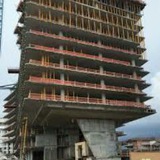AL-SAFI for Struct. Engg. الصافي للهندسة الانشائية
كيف يتم تحليل الاعمدة بطريقة تحليل الرتبة الثانية( 2nd (Order Analysis
هل من الممكن معالجة هذه الحالة؟
وكيف سيكون ذلك؟
وماهي طريقة التنفيذ التي ستتبع؟
وما الواجب عملة قبل اي دراسة او تصاميم؟
وكيف سيكون ذلك؟
وماهي طريقة التنفيذ التي ستتبع؟
وما الواجب عملة قبل اي دراسة او تصاميم؟
وكأن المقاول والمالك كانا يظنان ان الثلاثة ادوار الاخيرة شامخة شموخ الاهرامات لكن فقط بالنية وليس بالعمل.. انها مصر العظيمة التي علمتنا الهندسة واصبحت للاسف تفتقر لاساسيات وقواعد البناء في الجوانب التنفيذية وهذا ليس لقلة في عدد المهندسين او ضعف الجانب الهندسي لكن بسبب طمع بعض الناس وفساد الجهاز الاداري.
ماهو ابنظام الانشائي الذي اعتمد لتحليل وتصميم مثل هكذا منشأ.. دعونا ايضا نتتبع مسار التحميل ونعرف القوى الداخلية في كل عضو انشائي بحيث يشمل السقف التحويلي والاساسات التي لا تظهر في الصورة ودعونا نتخيل كم اامساحة والسماكة الكلية لهذا الاساس الذي اظنه لو كان سطحيا او ضحلا لكان الجزء الناتي من مركز التحميل كابولي كبير جدا ولو الاساس وتدي لتداخلت الاجهادات الناتجة عن الاوتاد لضيق منطقة توزيع الاوتاد تحت الاساس..
منقول من الفيسبوك
Pre-tensioning is a technique used in the construction of roads and bridges to improve the strength and durability of concrete structures. It involves the following steps:
Via: Engineering Clarified
1. Tensioning Steel Strands: Before the concrete is poured, steel tendons are stretched along the length of a casting bed.
2. Pouring Concrete: Once the tendons are tensioned, concrete is poured around them. As the concrete sets, it adheres to the tensioned steel.
3. Cutting the Tendons: After the concrete has reached a sufficient strength, the tendons are cut. The tension is transferred from the tendons to the concrete through the bond, effectively compressing it.
The pre-tensioning process imparts compressive stress to the concrete, counteracting the tensile stresses that will occur when the structure is put into service. This enhances the load-carrying capacity of the structure and helps to control cracking, leading to more durable roads and bridges.
Pre-tensioning is a technique used in the construction of roads and bridges to improve the strength and durability of concrete structures. It involves the following steps:
Via: Engineering Clarified
1. Tensioning Steel Strands: Before the concrete is poured, steel tendons are stretched along the length of a casting bed.
2. Pouring Concrete: Once the tendons are tensioned, concrete is poured around them. As the concrete sets, it adheres to the tensioned steel.
3. Cutting the Tendons: After the concrete has reached a sufficient strength, the tendons are cut. The tension is transferred from the tendons to the concrete through the bond, effectively compressing it.
The pre-tensioning process imparts compressive stress to the concrete, counteracting the tensile stresses that will occur when the structure is put into service. This enhances the load-carrying capacity of the structure and helps to control cracking, leading to more durable roads and bridges.
